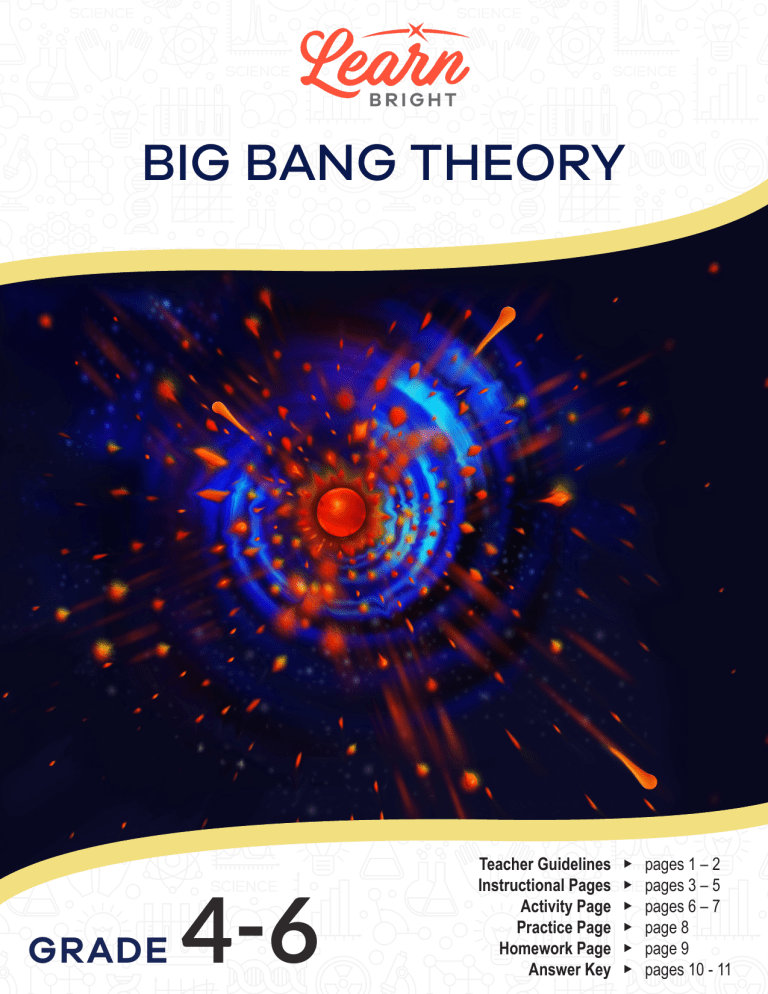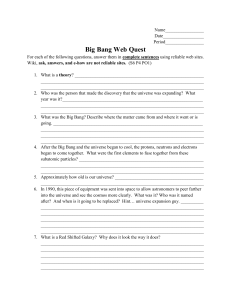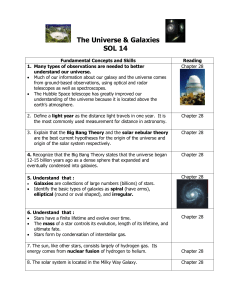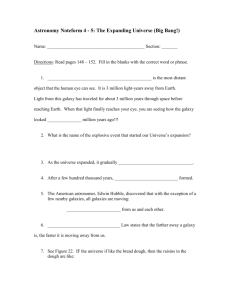
BIG BANG THEORY GRADE 4-6 Teacher Guidelines Instructional Pages Activity Page Practice Page Homework Page Answer Key ▶ ▶ ▶ ▶ ▶ ▶ pages 1 – 2 pages 3 – 5 pages 6 – 7 page 8 page 9 pages 10 - 11 Classroom Procedure: 1. Distribute Big Bang Theory content pages. Read aloud the first paragraph. 2. Allow students to respond and discuss the questions. In addition, ask: Why do you think there are many questions about the beginning of the Universe? Do any of you ever ask yourself the question: Why are you here? 3. Allow for responses and discussion. 4. Continue with the content pages. Read and review the remaining information with the students. Save the final question for the lesson closing. 5. It is strongly suggested a video from the additional resources be used to help students better understand this often-complicated theory. Use the additional resources to enhance understanding. 6. Distribute Activity page. Read and review the instructions. Pair students. Give students sufficient time to complete their plays. Encourage students to be creative, and they may use humor, refer to imaginary characters such as aliens, etc. 7. Once all plays are completed, students present them to the class. Following each play, review facts which may have been incorrectly stated. Check for understanding. 8. Distribute Practice page. Check and review the students’ responses. 9. Distribute the Homework page. The next day, check and review the students’ responses. 10. In closing, ask: If you could create the perfect Universe, what would it be like? Approximate Grade Level: 4 – 6 Objectives: The students will be able to define and explain the Big Bang Theory. State Educational Standards* LB.ELA-Literacy.SL.4.1 LB.ELA-Literacy.SL.4.1.C LB.ELA-Literacy.SL.4.5 LB.ELA-Literacy.SL.5.1 LB.ELA-Literacy.SL.5.1.C LB.ELA-Literacy.SL.5.5 LB.ELA-Literacy.RST.6-8.4 LB.ELA-Literacy.RST.6-8.7 LB.ELA-Literacy.RST.6-8.10 Class Sessions (45 minutes): At least 2 class sessions. Teaching Materials/Worksheets: Big Bang Theory content pages (2), Activity page, Practice page, Homework page Student Supplies: Optional Internet access, handouts Prepare Ahead of Time: Students will need to be paired. Copy handouts. Options for Lesson: Students may work in threes for the activity. Students may write a single paper from the perspective of a particle from a planet or star. Following students’ sharing or two-part plays, other students vote for the best play. Turn some of the two-man plays into large productions, with scenery, action, etc. *Lessons are aligned to meet the education objectives and goals of most states. For more information on your state objectives, contact your local Board of Education or Department of Education in your state. 1 Teacher Notes The lesson introduces the students to the theory of the Big Bang and the beginning of the universe about 14 billion years ago. The students may have a hard time grasping the enormity of the universe and the amount of time that has passed since its inception. Nevertheless, the lesson helps students become aware of the theory and the ever-expanding universe relative to matter and energy. There are numerous Internet sites with Big Bang Theory information. It is a lesson that can be used in conjunction with other lessons related to matter, stars, the solar system, etc. _________________________________________________________________________________________ _________________________________________________________________________________________ _________________________________________________________________________________________ _________________________________________________________________________________________ 2 Big Bang Theory How did the Earth, moon, planets, stars, and galaxies form? This is a question that has baffled many scientists over the years, and the question is researched continuously by many different experts, and will be forever. Have you ever wondered about the same question? The Big Bang Theory is the answer many scientists agree with and is the most popular theory related to the beginning of the universe. It is a theory first suggested by a priest named Georges Lemaître in the 1920s. His theory stated that the universe began from a single atom at the beginning of time. In short, the theory states that nearly 14 billion years ago, the universe began with not necessarily an explosion, but actually the expansion of the universe. The occurrence produced two things needed to make just about anything: matter and energy. This all took place in a fraction of a second. The matter was very dense, meaning it was extremely packed into a small area, as well as incredibly hot. From this small start, the universe then expanded in size very quickly, but the expansion began to slow down. However, matter continued to be destroyed and the energy produced created new particles. The leftover matter is what eventually became the stars, planets, and other particles that can be found in space. According to the Big Bang Theory, the expansion is still continuing today. Prior to the Big Bang, scientists are unsure of what exactly may have occurred. However, about 14 billion years ago the Universe began its growth and has resulted into what it is today, and continues to expand. Scientists have worked backwards to help them explain the Big Bang Theory and have gathered plenty of evidence and information about the Universe. They know galaxies are moving away from us today, and the further away a galaxy is, the faster 3 it is moving away. This theory can be proven during a normal explosion; the fastest moving objects end up the furthest away from the explosion. Cosmic microwave background radiation has also been detected in space. Speaking plainly, the CMBR is the leftover heat from the original explosion or expansion. Scientist have studied the light coming from far away stars and galaxies. By studying the changes in wavelengths of faraway light, astronomers have learned that distant galaxies are moving away from us, and as stated earlier, the further away it is, the faster it is moving. This tells scientists that everything in the Universe is moving away from everything else. Formation of Stars and Planets The objects in space, including stars, were formed when the particles and gases from the expansion of the Universe pull together because of gravity. When this occurs, it gets hot enough for nuclear reactions to begin. Energy is released and the star remains hot. When smaller amounts of dust and gas are pulled together due to gravity, planets are formed which then begin to orbit around the star. The Earth’s solar system was formed this way about 4 or 5 billion years ago, which means it formed about 9 billion years after the Big Bang. The Earth’s Sun, which is a star, is about halfway through its current stable phase. Eventually, the Sun will go through different phases and eventually die out, but not for another 5 billion years or longer. The Sun is just one star of more than about 100 billion stars in the Milky Way galaxy. The formation of stars and plants did not start immediately following the Big Bang. The process would have taken millions and millions of years. In fact, there was most likely no light during the first 400 million years following the Big Bang. 4 Astronomers are constantly observing space and seeking the furthest and oldest galaxies to understand the properties of the early universe. The use of the Hubble Space Telescope is just one tool, among several others, that astronomers have used for their study. The name behind the telescope, Edwin Hubble, was the first to notice, during the 1920s, that the universe was expanding and was not staying still. A force, called dark energy, is thought to be the cause that is pulling the cosmos apart at faster speeds today than a long time ago. However, this dark energy is a mystery and remains undetected. Today, the existence of this energy, which is takes up about 73% of the Universe, is debated among scientists. The Big Bang is the most widely accepted theory for the beginning of the Universe and its present growth. Nevertheless, there are many questions that remain unanswered, including those related to dark matter and dark energy. Astronomers and other scientists will continue to study the Universe in hope of discovering more answers to the many questions. If you could create the perfect Universe, what would it be like? 5 Activity Name __________________________ Date _________ Instructions 1. Imagine you and your partner are each a single particle and a part of the Big Bang nearly 14 billion years ago. 2. One of you will eventually become the part of a planet of your choosing, and one of you will become a particle of a star or the Sun. 3. You will create a short two-person play “talking to each other” as particles about the Big Bang Theory from the particles’ perspectives. 4. The play will not include props, different scenes or action. 5. Use the content pages and other available resources for accurate information for the two-part play. This may include the Internet. 6. Use scratch paper to take notes and to create a rough draft. Be creative. 7. Use the spaces below to write the final copy of your play. 8. Each of you should have approximately the same amount of lines. 9. Use additional paper if more space is needed. 10. Once completed you will perform the play for the class. PP = Planet Particle SP = Star Particle PP SP PP SP PP SP 6 Activity Name __________________________ Date _________ PP SP PP SP PP SP PP SP PP SP PP SP PP 7 Practice Name __________________________ Date _________ Answer each question 1. Name the man who first noticed the universe was expanding and not staying still:_________________ 2. Particles and gases from the expansion of the universe pull together because of __________________ 3. Approximately, how old is the solar system? ______________________________________________ 4. What do scientists believe causes the pulling apart of the cosmos? ____________________________ 5. What actually is CMBR? ______________________________________________________________ 6. Who first stated that the universe began from a single atom? _________________________________ 7. Approximately, about how many billions of years ago did the universe begin? ____________________ 8. What is the most popular theory that explains the beginning of the universe? _____________________ 9. True or False: The universe expanded billions of years ago, but is no longer expanding any further. 10. The Sun and about 100 billion others stars are a part of which galaxy? _________________________ 11. What is the name of the telescope used by scientists to help explore space? _____________________ 12. True or False: The solar system was formed about 9 billion years after the Big Bang. 13. Which two things are needed to make just about anything? __________________________________ 14. What eventually became the stars and planets found in space?________________________________ 15. When small amounts of dust and gas were pulled together, what were formed? ___________________ 16. According to scientists, dark energy takes up about what percent of the universe? ________________ 17. True or False: The Big Bang Theory is the only and correct theory for the universe’s creation. 18. Following the beginning of the Big Bang, when did light first appear? ___________________________ 8 Homework Name __________________________ Date _________ Tell the meaning of each number related to the Big Bang Theory 1. 1920s 2. 9 billion 3. 73 Correctly fill in each blank 1. According to the Big Bang Theory, the universe began from a single ___________________. 2. The beginning of the Big Bang Theory most likely began in just a fraction of a _____________. 3. The universe initially began and expanded very _______________, but later slowed down. 4. Leftover _____________ eventually became the stars, planets, and other particles found in space. 5. Prior to the Big Bang Theory, scientists are _______________ of what exactly happened. 6. The further a galaxy is moving away, the _______________ the galaxy is moving. 7. CMBR stands for __________ microwave background radiation, which is leftover heat. 8. Scientists have studied changes in light _______________ to learn about distant galaxies. 9. Everything in the universe is _______________ away from everything else. 10. The Sun has about another _______________ years before it begins to die out. 11. _______________ are constantly observing space and seek old galaxies to learn about space. 9 Practice Answer Key Name __________________________ Date _________ Answer each question 1. Name the man who first noticed the universe was expanding and not staying still: Edwin Hubble 2. Particles and gases from the expansion of the universe pull together because of gravity 3. Approximately, how old is the solar system? 4-5 billion years 4. What do scientists believe causes the pulling apart of the cosmos? Dark energy 5. What actually is CMBR? Leftover heat from the original explosion or expansion 6. Who first stated that the universe began from a single atom? Georges Lemaitre 7. Approximately, about how many billions of years ago did the universe begin? 14 8. What is the most popular theory that explains the beginning of the universe? Big Bang 9. True or False: The universe expanded billions of years ago, but is no longer expanding any further. 10. The Sun and about 100 billion others stars are a part of which galaxy? Milky Way 11. What is the name of the telescope used by scientists to help explore space? Hubble Space 12. True or False: The solar system was formed about 9 billion years after the Big Bang. 13. Which two things are needed to make just about anything? Matter and energy 14. What eventually became the stars and planets found in space? Particles and gases 15. When small amounts of dust and gas were pulled together, what were formed? planets 16. According to scientists, dark energy takes up about what percent of the universe? 73% 17. True or False: The Big Bang Theory is the only and correct theory for the universe’s creation. 18. Following the beginning of the Big Bang, when did light first appear? 400 million years later 10 Homework Answer Key Name __________________________ Date _________ Tell the meaning of each number related to the Big Bang Theory 1. 1920s Big Bang first suggested by Georges Lemaitre, that universe began from a single atom. Edwin Hubble discovered the universe was expanding. 2. 9 billion Years later that the solar system formed after the Big Bang 3. 73 Percent of space dark energy takes up in the universe Correctly fill in each blank 1. According to the Big Bang Theory, the universe began from a single atom. 2. The beginning of the Big Bang Theory most likely began in just a fraction of a second. 3. The universe initially began and expanded very quickly, but later slowed down. 4. Leftover matter (particles) eventually became the stars, planets, and other particles found in space. 5. Prior to the Big Bang Theory, scientists are unsure of what exactly happened. 6. The further a galaxy is moving away, the faster the galaxy is moving. 7. CMBR stands for cosmic microwave background radiation, which is leftover heat. 8. Scientists have studied changes in light wavelengths to learn about distant galaxies. 9. Everything in the universe is moving away from everything else. 10. The Sun has about another 5 billion years before it begins to die out. 11. Astronomers are constantly observing space and seek old galaxies to learn about space. 11



